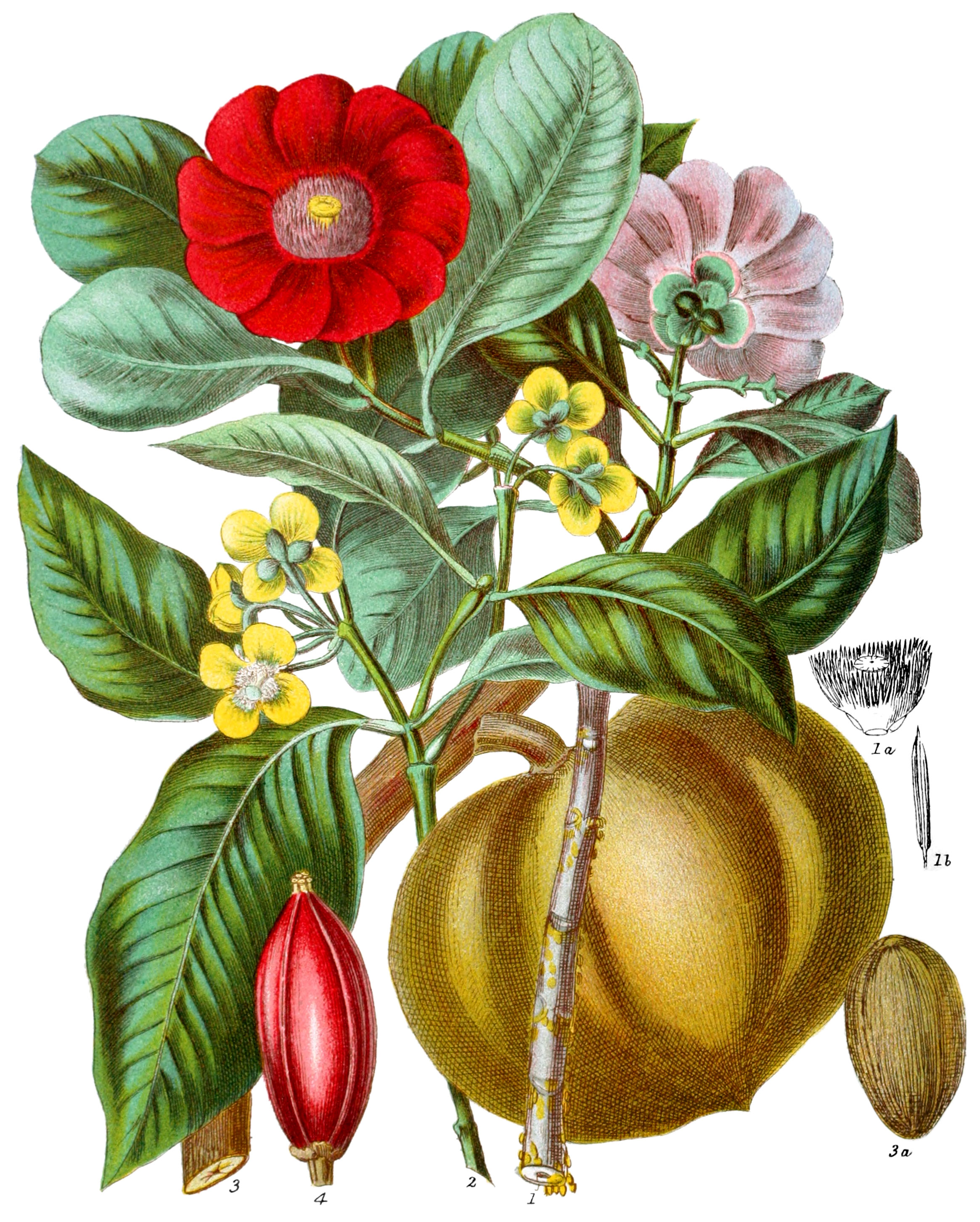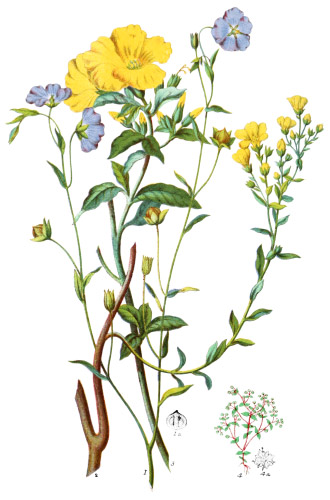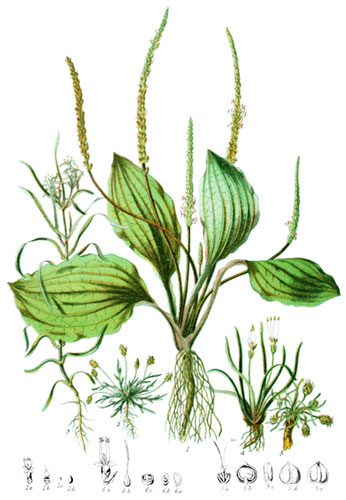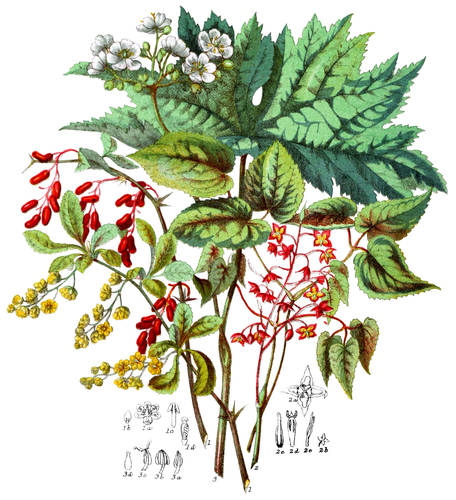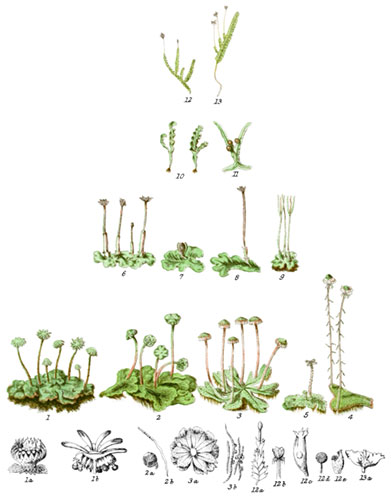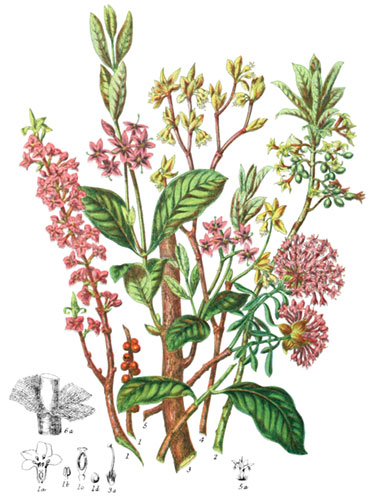Key characteristics
Trees and shrubs, some of which are parasitical; nearly all yield a resinous juice. The leaves are opposite, without stipules, leathery, entire at the edge, with a strong mid-rib, the side veins often running straight to the margin. The flowers are usually numerous, terminal, or from the base of the leaf-stalk, jointed to their stalk, having occasionally stamens and pistils in separate flowers. The calyx has two, four, six, or eight sepals, in alternate pairs, usually persistent, round, membranous, unequal, frequently coloured like petals. The flower is composed of petals equal in number to the sepals of the calyx, sometimes passing insensibly into them. The stamens are numerous, distinct or combined in sets, placed below the ovary, rarely of any definite number; the filaments are of various lengths, the anthers usually bursting inwards, sometimes opening by a pore, or transversely, sometimes immersed in a fleshy receptacle. The ovary is solitary, one or many-celled; the ovules are solitary or numerous. The style is very short or absent; the stigma is circular or radiate. The seeds are often embedded in pulp, their covering thin and membranous, frequently having a torn covering at the base.
This Order has an affinity with Hypericaceæ, but differs in the parts of the flower being of even numbers, instead of five, in the jointed flower-stalk, and in other points.
An acrid, yellow resinous gum is the prevalent secretion of these plants.
Select plants in this order
Not all plants listed are illustrated and not all plants illustrated are listed.
- Clusia, the type of this Order, was named after an excellent botanist and traveller of Flanders in the sixteenth century. The trees abound in a glutinous balsam, and are of considerable beauty of foliage, flower, and fruit.
- C. insignis (1) is one of the finest species, yielding a copious aromatic resin from the stalks and stem, drops exuding from the scars of the leaf-stalks; the stigma, also, which is densely clothed with small scales, is usually covered with a yellow wax-like resin; when dry, it becomes brown and resembles benzoin.
- C. rosea is an extremely beautiful tree, growing on rock and not unfrequently on other trees, the glutinous seeds taking root in hollow parts, in the same manner as the Mistletoe, but the resemblance of habit soon ceases, for Clusia, being capable of attaining a height of thirty feet, cannot remain in its parasitical situation; roots protrude from the cavity and descend to the ground, sometimes from an elevation of forty feet, there taking more independent growth, the tree soon acquires its natural vigour and size. The fruit when ripe opens at the divisions of the cells, exposing scarlet mucilaginous seeds.
- C. alba has a stem of one foot in diameter, with a spreading crown, the white flowers are small, the petals hollow; the red fruit filled with pulp and seeds, affords food to the birds of the forests in South America.
- Gercinia speciosa (2) is the largest example of the flowers of this genus, of a bright colour and extreme fragrance. The leaves are large and glossy. Almost every part of the tree yields a yellow juice, resembling gamboge.
- The fruit of G. Mangostana is the delicious Mangosteen of the Malay Isles and the Indian Archipelago; the fruit is of the shape of an orange, rough on the exterior.
- G. cochinchinensis is supposed to produce the genuine gamboge used in medicine and for painting; it comes to Europe and sticks, apparently having been rolled up in strong fibrous leaves whilst in a soft state.
- G. pictoria, of the East Indies, affords a gamboge of brilliant yellow, but not so permanent as the Chinese.
- The juice of Xanthochymus pictorius is of inferior quality, though used as gamboge.
- Mammea americana (3) is called abricotier by the French colonists in the West Indies, on account of the colour and consistency of the pulp of the fruit; it grows in the Caribbee Isles and on the continent of South America; from the flowers the natives made the first spirituous beverage known to them.
- The seeds of Calophyllum inophyllum contain oil, and resin exudes from the roots.
- C. Calaba produces the East Indian resin Tacamahaca.
- The aromatic pale yellow resin of South America is obtained from C. brasiliense.
- Verticillaria yields the balsam of Maria, and several other species contain a large proportion of balsam.
- Pentadesma butyracea is the butter and tall-tree of Sierra Leone.
- Moronobea coccinea is supposed to afford the resinous substance called hog-gum, used as pitch.
- Some of these trees are used for their timber; that of Mesua is said to be extremely hard; Calophyllum angustifolium is the Piney-tree, from which remarkably straight spars are obtained in the islands to the east of the Bay of Bengal.
Locations
All these trees are natives of the Tropics; the greater part belong to South America; a few grow in Madagascar, and on the continent of Africa. Extreme heat and humidity are essential to nearly the whole Tribe.
Legend
- Clusia insignis, Noble Balsam-tree. Tropical America.
- Stamens and Pistil.
- Stamen, magnified.
- Garcinia speciosa, Showy Garcinia. East Indies.
- Mammea Americana, Mammee Apple. South America.
- Seed.
- Fruit of Clusia alba, White-flowered Balsam-tree. South America.
Explore more
Posters
Decorate your walls with colorful detailed posters based on Elizabeth Twining’s beautiful two-volume set from 1868.
Puzzles
Challenge yourself or someone else to assemble a puzzle of all 160 botanical illustrations.
